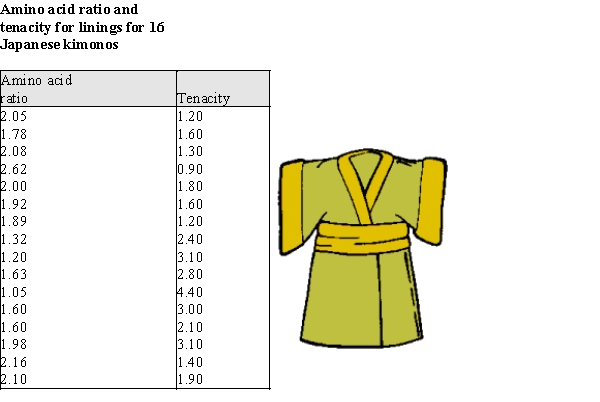Exhibit 4-1
The preservation of objects made of organic material is a constant concern to those caring for items of historical interest. For example, some delicate fabrics are natural silks--they are made of protein and are biodegradable. Many silks in museum collections are in danger of crumbling. It would be of great benefit to be able to assess the delicacy of the fabric before making decisions about displaying it. One possibility is chemical analysis, which might give some evidence about the brittle nature of a fabric. To investigate this possibility, bio-chemical data in the form of a ratio of the amount of certain amino acids in the fibers was acquired from the linings of sixteen 19th and early 20th century Japanese kimonos, and the tenacity (breaking stress) of the fabric was also recorded.
Using the data from the Japanese kimonos, construct the least squares best fit line predicting tenacity using amino acid ratio as a predictor. 
-Refer to Exhibit 4-1.
Approximately what proportion of the variability in tenacity is explained by the amino acid ratio?
Correct Answer:
Verified
Q11: What is it that the Pearson correlation
Q36: In the 19th Century, venereal diseases were
Q37: Twenty-five assembly-line workers participated in a study
Q38: When children and adolescents are discharged from
Q39: Exhibit 4-3
Paleontology, the study of forms of
Q41: The model W = a + bL
Q42: Exhibit 4-2
The theory of fiber strength suggests
Q43: Suppose that the coins analyzed in Exhibit
Q44: Exhibit 4-4:
Biological theory suggests that the relationship
Q45: A common statistical method for estimating a
Unlock this Answer For Free Now!
View this answer and more for free by performing one of the following actions

Scan the QR code to install the App and get 2 free unlocks

Unlock quizzes for free by uploading documents